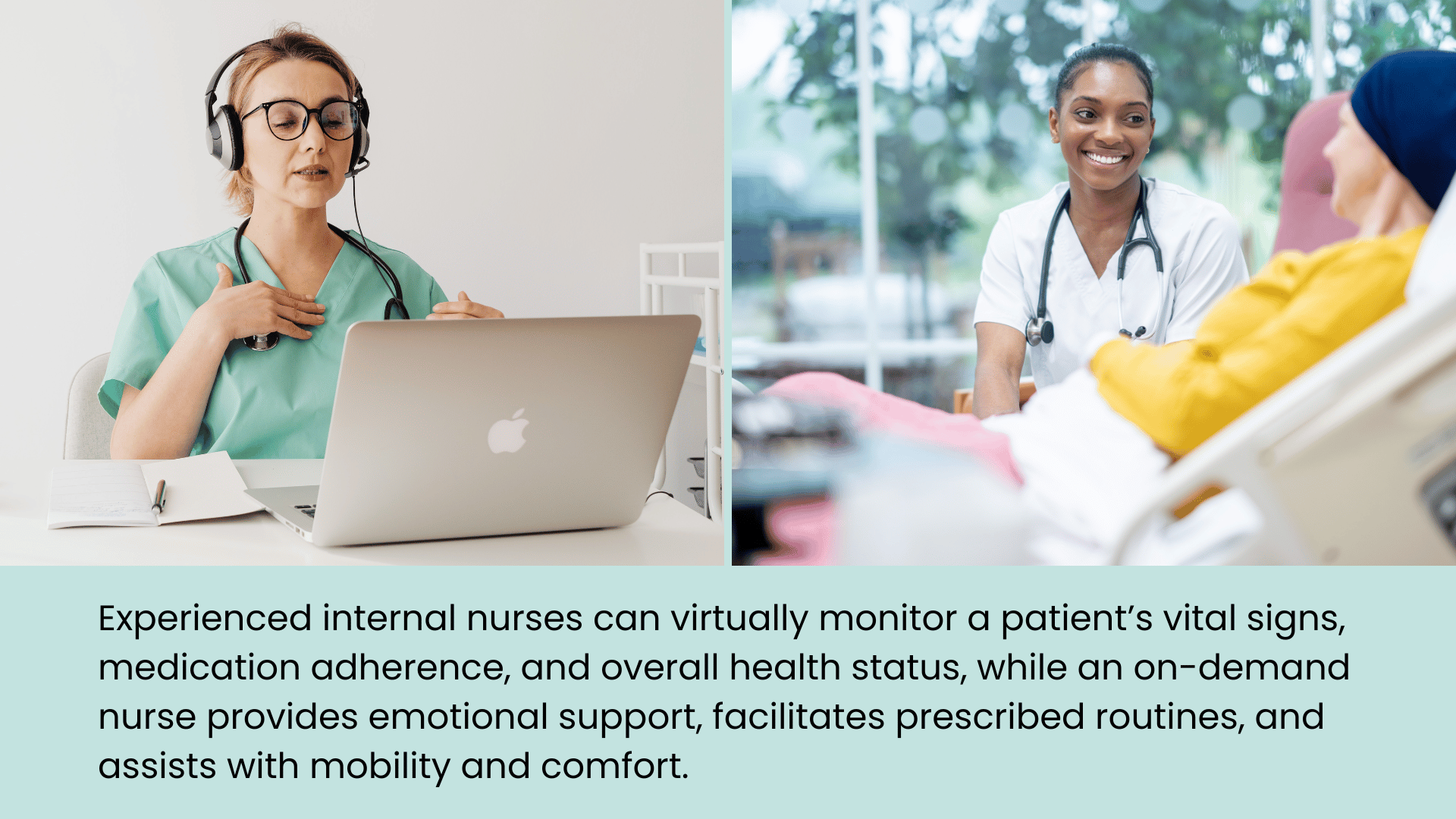What Is a Hybrid Care Model? How Virtual Nursing and Flexible Staffing Transform Patient Care

Hospitals are bracing for a perfect storm: rising patient demand, worsening nurse shortages, and relentless financial pressures. Seasonal surges make the problem even harder to manage, leaving leaders scrambling to cover shifts without burning out their workforce or compromising care quality. The solution gaining momentum? Flexible hybrid care models.
What Is a Flexible Hybrid Care Model?
In hospitals and health systems, a flexible hybrid care model combines virtual nurses and on-demand bedside nurses to deliver flexible, efficient care. Virtual nurses handle admissions, discharges, patient education, and documentation remotely, freeing bedside staff to focus on direct care. On-demand nurses step in during peak demand or seasonal surges to keep units fully staffed. Working together, they create a model that maintains patient continuity, eases staff workload, and helps hospitals control labor costs.
Why Health Systems Should Consider Hybrid Care
Health systems are under increasing pressure from both workforce and operational challenges. Nurse shortages, high burnout rates, and retention struggles make it harder to maintain stable staffing levels. At the same time, seasonal surges, unpredictable patient volumes, and rising labor costs strain resources and disrupt care delivery.
Hybrid care offers a practical solution. By combining virtual nurses with flexible per diem staffing, hospitals can reduce the burden on bedside teams, adapt quickly to fluctuating demand, and protect patient outcomes. Research supports the model: Studies show virtual nursing can reduce inpatient stays by over 7% and cut readmissions by 2%—a significant impact as the U.S. faces a projected 300,000-nurse shortfall by 2027.

Key Hybrid Care Model Benefits
Hybrid care models deliver value across patients, staff, and operations, making them a powerful workforce strategy for today’s health systems.
Better Patient Outcomes
By pairing virtual and bedside support, hospitals can provide continuous care, reduce readmissions, and shorten inpatient stays.
Improved Staff Satisfaction
Sharing the workload between virtual and on-demand nurses lowers burnout, balances assignments, and supports stronger nurse retention.
Operational Efficiency
Flexible staffing and virtual support help optimize labor costs, reduce overtime, and maximize resources.
Agility During Surges
Hybrid care makes it easier to scale staffing without sacrificing quality, whether it's flu season, the holidays, or unexpected spikes.

How Virtual and On-Demand Nurses Work Together
Hybrid care works because virtual and on-demand nurses complement one another in real time.
Workflow Integration
Virtual nurses manage admissions, discharge planning, patient education, and documentation remotely, while on-demand nurses step in at the bedside to provide direct care and cover gaps during high-demand periods.
Complementary Functions
By taking on administrative and remote tasks, virtual nurses free bedside staff to focus on patient care. On-demand nurses then provide the flexibility to meet fluctuating volumes without overburdening full-time staff.
Real-World Example
During flu season, virtual nurses can handle a surge in admissions and discharge coordination, while on-demand nurses cover additional bedside shifts. This combination keeps patient throughput moving, reduces wait times, and maintains staff balance without compromising care quality.
Which Healthcare Facilities Benefit Most
While any health system can benefit from hybrid care, some facilities see a powerful impact:
Hospitals: Hybrid care helps manage high patient volumes, streamline admissions/discharges, and reduce readmissions.
Long-Term Care / Skilled Nursing Facilities: Virtual nurses provide ongoing monitoring and education, while on-demand staff fill bedside gaps to maintain consistent coverage.
Outpatient and Ambulatory Centers: Hybrid staffing ensures efficient throughput, with virtual nurses handling follow-ups and on-demand staff supporting peak schedules.
Home Health and Telehealth Services: Virtual nurses extend care reach, while flexible bedside staff support in-home visits.
Specialty Care Centers: Hybrid models balance specialized bedside care with virtual coordination, patient education, and monitoring.
Facility Type | Key Benefit of Hybrid Care |
|---|---|
Hospitals | Manage surges, streamline throughput, reduce readmissions |
Skilled Nursing Facility | Consistent coverage, enhanced patient monitoring |
Ambulatory Centers | Flexible scheduling, improved patient flow |
Home Health | Extended reach, seamless coordination |
Implementing a Hybrid Care Model
Adopting a hybrid care model requires thoughtful planning and alignment across leadership, technology, and staffing strategies. Key steps include:
Assess Staffing Gaps and Trends: Identify where patient surges, seasonal fluctuations, or chronic staffing shortages create the most strain.
Integrate Virtual Nursing Technology: Ensure platforms for telehealth, remote monitoring, and documentation fit seamlessly into existing workflows.
Build Flexible Staffing Pipelines: Develop a reliable float pool of local per diem nurses who can step in during peak demand.
Track Key Metrics: Monitor outcomes such as patient satisfaction, readmission rates, nurse workload, and labor costs to measure impact.
Follow Best Practices: Engage leadership, provide staff training, and align workflows to ensure virtual and on-demand nurses complement one another effectively.
Why Hybrid Patient Care Matters Now
Hybrid care is more than a workforce strategy. It’s a solution to today’s biggest healthcare workforce challenges. By combining virtual and on-demand nursing, health systems can achieve better patient outcomes, stronger staff support, and greater operational efficiency.
Forward-thinking leaders are already adopting hybrid care to stay resilient despite shortages, surges, and rising costs. The question is: Is your organization ready to make the shift?
Schedule a free ShiftMed workforce consultation to find out.